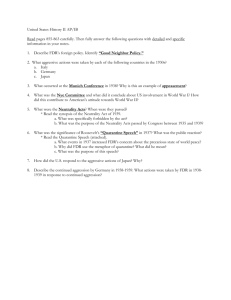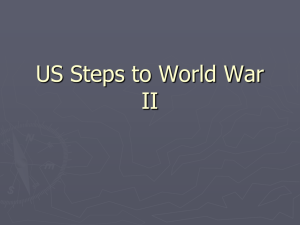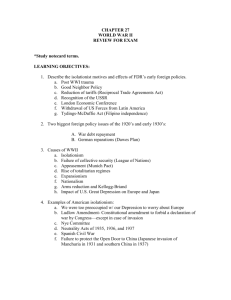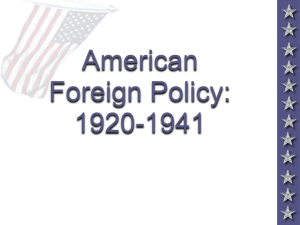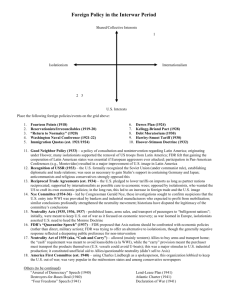American Foreign Policy: 1920-1941
advertisement
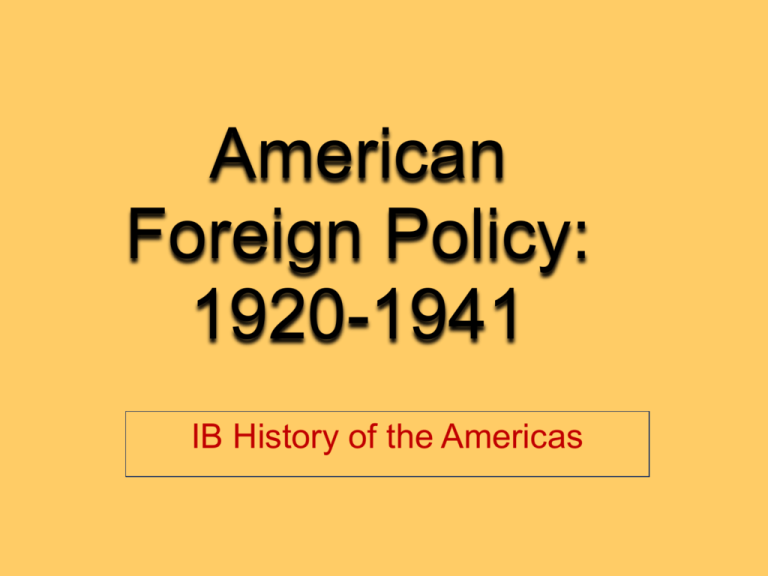
American Foreign Policy: 1920-1941 IB History of the Americas GUIDING QUESTIONS To what extent did the United States adopt an isolationist policy in the 1920s and 1930s? For what reasons did the United States go from being isolationist to interventionist? Supplement to this Discussion • As we discuss how the United States as a Nation transformed from being isolationist to engaging in war, we will be reading, analyzing, and discussing the following speeches from FDR: – – – – – “I Hate War” 1936 “Quarantine the Aggressors” 1937 “Arsenal of Democracy” 1939 “The Four Freedoms” January 1941 “Infamy” December 1941 Foreign Policy Tensions Interventionism Disarmament • Collective security • Isolationism • “Wilsonianism” • Nativists • Business interests • Anti-War movement • Conservative Republicans DIPLOMACY IN THE 1920S: ENGAGEMENT WITHOUT ENTANGLEMENTS Failure of the League of Nations • The US became “unofficial observers” • Senate voted down membership into the League, even though it was the cornerstone of Wilson’s 14 Points Punch Magazine December 1919 Failure of the League of Nations • Collective security by the League required nations to act against states they considered friends, and sometimes against national interests, to support states in which they had no interest. Ex. Mussolini and Ethiopia • The League depended on the Great Powers to enforce its resolutions. Britain and France, were reluctant to use sanctions or military action on behalf of the League. • The League's advocacy of disarmament for members while at the same time advocating collective security unwittingly deprived it of the only forceful means by which its authority could be upheld. Moral Suasion in Punch Magazine 1920 Washington Disarmament Conference (1921-1922) Long-standing Anglo-Japanese alliance (1902) obligated Britain to aid Japan in the event of a Japanese war with the United States. Goals naval disarmament and the political situation in the Far East. Five-Power Treaty (1922) A battleship ratio was achieved through this ratio: US Britain Japan France Italy 5 5 3 1.67 1.67 Japan got a guarantee that the US and Britain would stop fortifying their Far East territories [including the Philippines]. Loophole no restrictions on small warships, no enforcement mechanism European Debts to the US Hyper-Inflation in Germany: 1923 Dawes Plan (1924) Kellogg-Briand Pact (1928) 15 nations dedicated to outlawing aggression and war as tools of foreign policy. 62 nations signed. Problems no means of actual enforcement and gave Americans a false sense of security. DIPLOMACY IN THE 1930S: ENGAGEMENT to Isolationism Japanese Attack Manchuria (1931) League of Nations condemned the action. Japan leaves the League. Hoover wanted no part in an American military action in the Far East. Hoover-Stimson Doctrine (1932) US would not recognize any territorial acquisitions that were achieved by force. Japan was infuriated because the US had conquered new territories a few decades earlier. Japan bombed Shanghai in 1932 massive casualties. Critics argue all this did was further alienate the Japanese Hoover’s Foreign Policy in Latin America – 1928, goodwill tour, Hoover renounces the Roosevelt Corollary of Monroe Doctrine of 1823Roosevelt asserted that European nations should not intervene in countries to the south of the US, however under certain conditions, United States intervention might be justified. Hoover’s Foreign Policy in Latin America – Begins formulation of Good Neighbor Policy (nonintervention policy) – U.S. helped negotiate the Treaty of Lima 1929, ending a 60 yr conflict between Chile and Peru FDR’s “Good Neighbor” Policy Important to have all nations in the Western Hemisphere united in lieu of foreign aggressions. FDR The good neighbor respects himself and the rights of others. Policy of non-intervention and cooperation. FDR Recognizes the Soviet Union (late 1933) FDR felt that recognizing Moscow might help the US against Japan. Maybe trade with the USSR would help the US economy during the Depression. U.S. Isolationism • Geneva Conference- arms limitation talks – 1933, Hitler and Mussolini withdraw – 1935, Japan withdraws from Washington Conference naval agreements • Reasons for U.S. isolationism: – Failure of “internationalists” and the League to limit aggression (ex. Japan-China and Italy-Ethiopia) – Nye Committee Report blaming munitions & banking industry for U.S. involvement in WWI. – Public opinion against U.S. involvement in Europe, leading to the Neutrality Acts FDR’s “I hate war” Speech (1936) From Isolationism to War Neutrality Acts: 1935, 1936, 1937 Congress responds to voters to prevent a repeat of the events that led U.S. into WW I. When the President proclaimed the existence of a foreign war, certain restrictions would automatically go into effect: Prohibited sales of arms to belligerent nations. Prohibited loans and credits to belligerent nations. Forbade Americans to travel on vessels of nations at war Non-military goods must be purchased on a “cash-andcarry” basis pay when goods are picked up, no loans This limited the options of the President in a crisis. America in the 1930s declined to build up its forces! US Neutrality U.S. Isolationism / Neutrality Acts 1937 • Neutrality Act 1937 – Sino-Japanese War. FDR supports China's efforts to defend & did not invoke the Neutrality Acts and allowed arms shipments to China. – This outraged the isolationists in Congress who claimed that the spirit of the law was being undermined. Roosevelt stated that he would prohibit American ships from transporting arms to the belligerents, but he allowed British ships to transport American arms to China. – Extended 1939 to provide assistance to Great Britain U.S. Isolationism / Quarantine Speech • Chicago October 1937 – FDR warns that Japanese aggression is a threat to world peace and that aggressors should be “quarantined” by the world community to prevent the spread of the “contagion of war” – Public reaction to the speech was overwhelmingly hostile. Most saw it as FDR’s attempt to justify and further aid to belligerent nations Panay Incident (1937) December 12, 1937. Japan bombed USS Panay gunboat & three Standard Oil tankers on the Yangtze River. The river was an international waterway. Japan was testing US resolve! Japan apologized, paid US an indemnity, and promised no further attacks. Most Americans, especially isolationists were satisfied with the apology. Results Japanese interpreted US tone as a license for further aggression against US interests. German Aggression – 1935 – compulsory military service; revives German army – Occupies Rhineland, 1936 – Annexes Austria (anschluss), 1938 – September 1938, annexation of the Sudetenland (western Czechoslovakia) Munich Conference • Munich Conference- G.B., France and Germany – Hitler claims that his territorial claims are complete and Neville Chamberlain declares “peace in our time” • Six months later Germany occupies all of Czech. And turns his attention to Poland – GB and France pledge to defend Poland from Nazi attack 1939 Neutrality Act September 1, 1939, Hitler invades Poland, GB and France declare war on Germany In response to Germany’s invasion of Poland. FDR persuades Congress in special session to allow the US to aid European democracies in a limited way: The US could sell weapons to the European democracies on a “cash-and-carry” basis. FDR was authorized to proclaim danger zones which US ships and citizens could not enter. Results of the 1939 Neutrality Act: Aggressors could not send ships to buy US munitions. The US economy improved as European demands for war goods helped bring the country out of the 1937-38 recession. America becomes the “Arsenal of Democracy.” “This nation shall remain a neutral nation. But I cannot ask that every American remain neutral in thought as well.” ~FDR War Begins / US Intervention • May 1940, FDR asks Congress for 1 billion in defense funds. Gets it! • Fight for Freedom Committee- declare war now • America First Committee- nonintervention, Lindberg, Sen. Gerald Nye, & Hearst Publishing. • FDR runs for unprecedented third term. Beats Willkie with 55% of the popular vote Gallup Polls: European War and World War 1938–1940 Selective Service Act of 1940 • the first peacetime conscription in United States • This Selective Service Act required that men between the ages of 21 and 35 register with local draft boards. • Later, when the U.S. entered World War II, all men aged 18 to 45 were made liable for military service, and all men aged 18 to 65 were required to register. “America First” Committee Charles Lindbergh War Begins / US Intervention • England near bankruptcy and cannot afford “cash & carry” FDR introduces “Lend-Lease” – Lend or lease arms to any nation deemed “vital to the defense of the United States” – GB (and other allies USSR) get weapons on the “promise’ to pay later “Lend-Lease” Act (1941) Great Britain.........................$31 billion Soviet Union...........................$11 billion France......................................$ 3 billion China.......................................$1.5 billion Other European.................$500 million South America...................$400 million The amount totaled: $48,601,365,000 Atlantic Charter • British Prime Minister Winston Churchill and U.S. President Franklin D. Roosevelt • aboard warships in a secure anchorage in Ship Harbor, Newfoundland, and was issued as a joint declaration on 14 August 1941 • Outlines the war goals and goals of the post war world Atlantic Charter • In brief, the 8 points were: – No territorial gains were to be sought by the United States or the United Kingdom. – Territorial adjustments must be in accord with the wishes of the peoples concerned. – All peoples had a right to self-determination. – Trade barriers were to be lowered. – There was to be global economic cooperation and advancement of social welfare. – Freedom from want and fear; – Freedom of the seas; – Disarmament of aggressor nations, postwar common disarmament Japanese Aggression 19311941 US / Japan • Dec 7, 1941 Pearl Harbor attacked • U.S. naval force in the Pacific is greatly reduced • 2400 killed (over 1100 on Arizona), 1200 wounded; – 20 warships sunk or severely damaged; 150 planes destroyed • Dec 8, FDR asks for a declaration of war. • Dec 11 Germany & Italy declare war on U.S. – U.S. reciprocates FDR before Congress asking for a Declaration of War against Japan, Dec. 8, 1941 FDR Signs the War Declaration Paying for the War Betty Grable: Allied Pinup Girl (She Reminded Men What They Were Fighting For)
